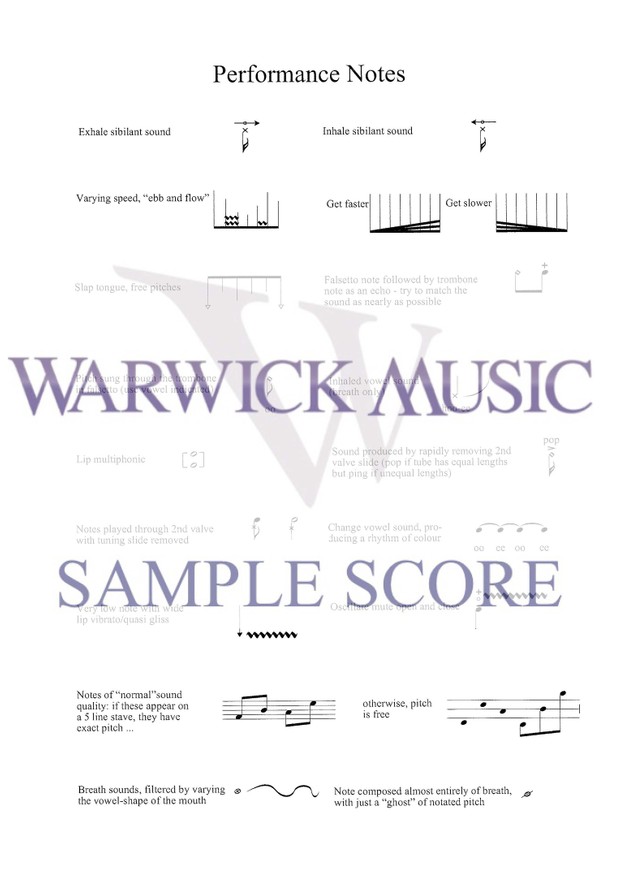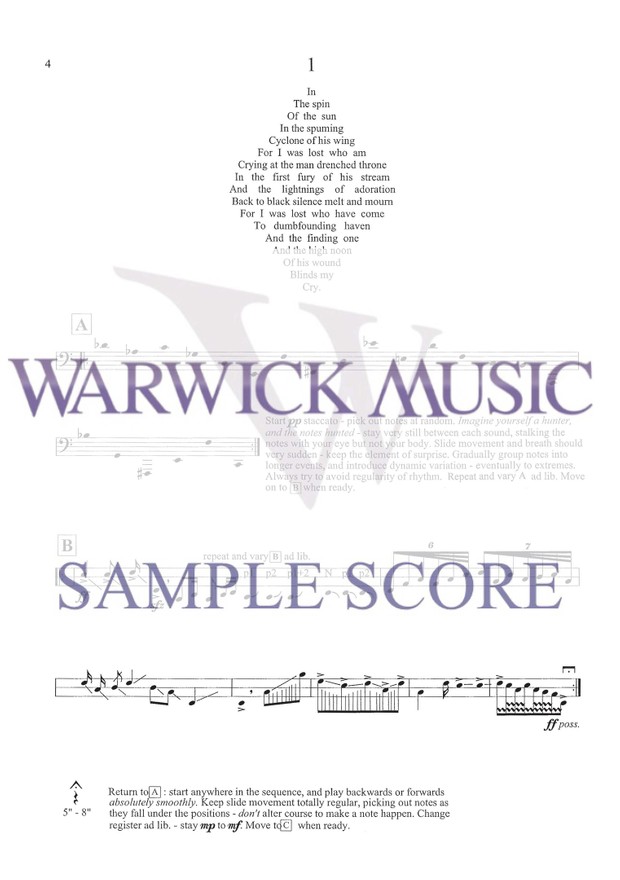£4.99



John Kenny: Bamburgh Beach - Solo Bass Trombone
Based on a poem by Dylan Thomas. Bamburgh Beach was written in September 1999, hard on the heals of my sonata for unaccompanied bass trombone - indeed, the piece is, effectively, a 2nd unaccompanied sonata for bass trombone, deriving from the same inspiration and motivation, and sharing certain important elements - although their notational techniques are extremely different.
Although I had already considered composing a piece for bass trombone, the catalyst was a joint commission from the International Trombone Association and the British Trombone Society to compose a piece for the American bass trombone virtuoso David Taylor. I already had very clear ideas about the kind of exploration I wanted to make of bass trombone sonority, in particular it’s expanded lip multiphonic range (deriving from it’s double valve system, in effect allowing four harmonic series in each slide position) but David Taylor’s highly individual personality as a performer provided a wealth of inspiration in itself. He is equally at home in the worlds of highly composed and controlled composition, jazz, or pure improvisation - and since my own interests as a performer are similarly diverse, I inevitably found myself pulled in two directions: my desire to produce a controlled, tightly notated piece led to the Bass Trombone Sonata, whilst my desire to give David Taylor a platform for his unique abilities as an improviser, and as a stage presence, lead to the looser structures of Bamburgh Beach.
Language - both the pure sound of language and poetic expression - is the other chief source material for both pieces. The Dylan Thomas poem used in Mvt 1 comes from the Collected Poems published in 1952. The poet’s use of a visual structure to contain the syllabic structure is very compelling, and inevitably influences the reader/speaker’s understanding of the words. It is a work of dark power and passion, moving from shadow to light and beyond. The weight, cadence, and mysterious meaning of these words individually and collectively inform the musical material of the movement, allowing the interpreter freedom for deep exploration of personal expression.
My own poem for the 2nd movement gives the piece its title, and was composed on the eve of the total solar eclipse in 1999, which caused such a media sensation. Up in Northumbria the eclipse was not total - but the effect, which I witnessed on the deserted beach below the Norman stronghold of Bamburgh, was something I have never quite experienced before. It was on that afternoon that my ideas for both the sonata and this piece clarified; this moment in time lies at the heart of both pieces.
The third movement is inspired by Eric Mottram’s wistful aphorism on the mutability of all life. This poem - almost a haiku - is taken from his collection “A Book of Herne”, which Mottram gave me just a few days before his unexpected death in January 1995. I had previously set it as the first movement of my “Songs From a Book of Herne” but found that it remained so strongly present in my own subconscious outlook on life at that time, that I simply had to look at again in a new context.
Bamburgh Beach was premiered by David Taylor at the Birmingham Conservatoire during the 1999 British Trombone Festival.
The poem quoted on page 4 is from verse four of Vision of Prayer by Dylan Thomas.
The Collected Poems of Dylan Thomas are published by J. M. Dent.
All purchases from our website are for a digital copy.
Warwick Music Publishing print sheet music is distributed globally and exclusively by Hal Leonard Europe. You can buy printed sheet music from a number of their approved retailers.
SKU: TB262
Composer: John Kenny
Difficulty: Advanced
Instrumentation: Bass Trombone
Range: B0-F#4



